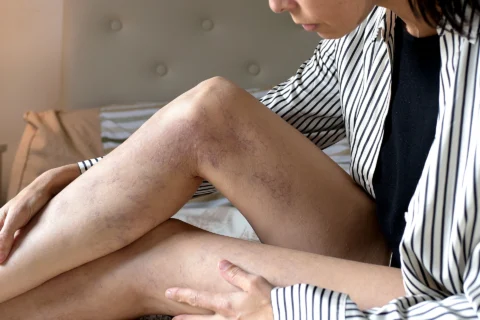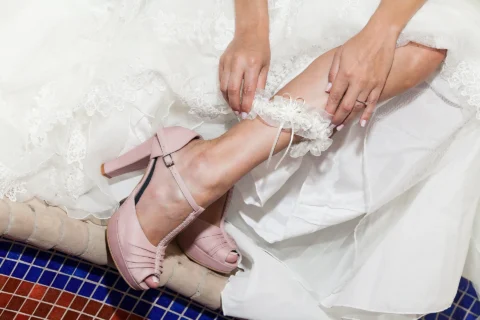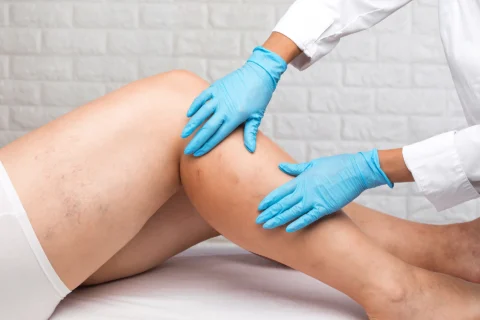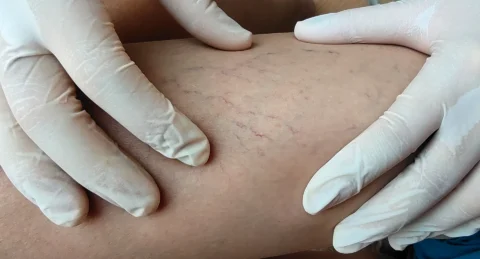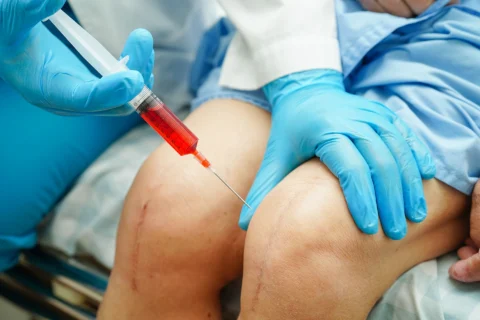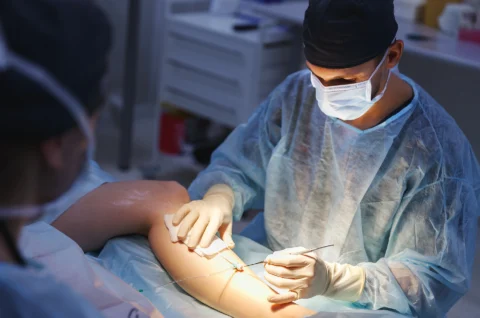When looking for information and tips to get rid of varicose veins in the lower leg, you might come across an article or two about minimal to profuse bleeding caused by untreated varicose veins. Some of these stories might seem far-fetched, but patients should see a vein clinic if their varicose veins rupture to prevent more serious conditions.
So what exactly happens when a varicose vein blows out? Ruptured varicose veins are usually caused by the increased pressure inside the blood vessel of the lower leg. The pressure buildup inside the saphenous vein causes the vein wall to stretch too thinly, making it weaker and more prone to spontaneous blowouts. Patients are advised to elevate their leg, apply pressure on it, and see a vein specialist immediately if they spot a ruptured vein.
Varicose Veins Can Blow Out: Is It Normal?
Blown veins occur when a needle accidentally injures a vein during IV treatment or a blood draw. While it sounds serious, most cases of blown veins don’t cause long-term damage. However, blown veins may also occur when a patient has a venous condition like a spider vein or varicose vein.
Visible surface veins like spider veins or varicose veins can be uncomfortable and unsightly. They’re a common cosmetic issue for lots of people – with more than 20% of adults likely developing bulging veins in their legs and other body parts at some point in their lives. According to some studies, women are also more likely to develop these larger veins than men.
When the damaged leg vein swells too much, it can suddenly rupture and cause uncomfortable symptoms. Varicose veins that blow out sound dangerous and scare off some patients, but understanding why they happen can help relieve some of the patient’s anxiety.
Symptoms of a Blown Vein
Bleeding is a common symptom of a blown varicose vein – the blood may leak into the nearby tissues, but it can also bleed through the skin if the patient’s skin is too thin. Aside from bleeding, here are other symptoms of blown vein that patients might experience:
- Sharp pain near the area of the damaged vein, which may continue to hurt for some time
- Swelling and tenderness of the skin around the area of the popped vein
- Bruising that causes the area to turn blue and black as the blood seeps into the tissues
- Redness which may worsen when the affected area is moved or pressure is applied
- Inflammation around the popped vein as the surrounding blood vessels also swell
Are Blown Varicose Veins Harmful?
Most of the symptoms of blown varicose veins can be extremely uncomfortable for some patients so they seek treatment immediately. A ruptured varicose vein in the leg also qualifies as a medical emergency which requires prompt treatment by a medical professional.
Getting the varicose veins treated immediately reduces the pain and other symptoms experienced by the patient. It also lowers their chances of developing more serious venous conditions. Remember to see a vein specialist immediately if the symptoms of the blown vein persist or worsen after a few days.
Why Do Varicose Veins Blow Up?
When the superficial vein has faulty valves, they make the blood flow backward (also known as venous reflux) or pool inside the vein. Venous reflux causes the affected vein to bulge, stretch, and weaken. And since varicose veins are weaker than healthy veins, they’re more prone to blowing out even with the slightest blow.
Possible Causes
Increased pressure inside the varicose vein is the common reason why it may rupture. A few factors increase blood pressure inside the blood vessel, including:
- Additional strain from activities like lifting heavy objects, coughing, improper bowel movement, and constipation may increase the pressure inside the veins.
- Injury or a blow in the affected area, even as minor as a scratch or bump, can cause the damaged leg vein to blow out.
- Prolonged standing or sitting causes blood to pool, resulting in increased pressure inside the vein and leading to the bursting of a blood vessel.
- Blood clots that form inside the varicose veins because of vein disease can also increase pressure inside the blood vessel, causing the damaged vein to burst.
Risk Factors
Anyone who has varicose veins is at risk of blowing them out because of various reasons. However, some patients are more likely to experience blown varicose veins than others because of these risk factors:
- Age – As people get older, their bodies also have some trouble regulating their blood flow.
- Genetics – Some people are born with weakened valves inside their blood vessels.
- Pregnancy – A pregnant woman experiences increased weight and hormonal changes which affect her blood pressure.
- Strenuous activities – Some physical activities like running, jumping, sitting, and standing for extended periods put extra pressure on the legs.
- Smoking – The toxins in cigarettes may damage and weaken the blood vessels.
- Drinking – Excessive alcohol intake causes dehydration, which increases the risk of blown varicose veins.
What Happens When You Have Blown Varicose Veins?
If a varicose vein bleeds, patients are advised to stop the bleeding immediately before heading to an emergency room or a vein clinic. It’s crucial to get proper treatment immediately because delaying the procedure may only result in significant blood loss and other health complications.

Possible Complications
Some of the possible complications of untreated varicose veins include:
- Chronic venous insufficiency occurs when the leg veins prevent blood from flowing back to the heart because of faulty vein valves.
- Superficial thrombophlebitis is the inflammation of the vein below the surface of the skin because of a blood clot (phlebitis).
- Deep vein thrombosis is a vein disease that occurs when a blood clot forms inside a deep vein in the lower leg, pelvis, thigh, or arm.
- Pulmonary embolism is another medical condition that occurs when a blood clot is stuck inside an artery in the lung, blocking the blood flow in the area.
- Venous leg ulcers appear in the legs because of blood circulation problems in the saphenous veins. A leg ulcer is also considered a late manifestation of chronic venous insufficiency.
What To Do Immediately
A burst varicose vein requires immediate medical attention, but there are some general steps that patients may take as they wait for a doctor or vein specialist.
- Step 1: Apply pressure to the blown varicose vein. Direct pressure in the treatment area using a clean cloth or gauze stops bleeding and prevents possible infection.
- Step 2: Elevate the area of the affected vein. Keeping the area of the blown varicose vein above the heart level helps reduce swelling. It also soothes pain and improves blood circulation in the area to speed up healing.
- Step 3: Visit a vein clinic immediately. Make sure to go to the nearest emergency room or vein clinic as soon as possible. The doctor examines the area first before suggesting the best course of treatment for the patient.
Treating Blown Varicose Veins at Vein Center Doctor
The good news is that patients can do some things to prevent their varicose veins from bursting, like:
- Moving around every 30 minutes instead of sitting or standing for too long.
- Wearing compression stockings for better blood flow.
- Exercising regularly to strengthen leg muscles.
- Maintaining a healthy weight to reduce pressure in the veins.
But if your varicose veins still blow out, our experts at Vein Center Doctor are here to recommend the best varicose vein treatment for your condition. Our vein specialist may prescribe one of the following treatments first before considering surgical procedures like vein stripping:
- Sclerotherapy – This non-surgical vein treatment involves injecting a salt solution into the damaged vein, causing its walls to get irritated and collapse. The blood from the collapsed vein then flows to a nearby healthy vein as the varicose vein disappears.
- Compression therapy – This traditional varicose vein treatment uses special compression stockings or socks to reduce swelling and achiness in the legs while improving the blood circulation there.
- Radiofrequency ablation – This revolutionary treatment for vein conditions uses heat to scar the varicose vein and trigger the body’s healing process. The collapsed veins disappear after a while, along with the uncomfortable symptoms experienced by patients.
Treat Your Varicose Veins Today at Vein Center Doctor

In most cases, varicose veins can be managed with minimally invasive treatments to prevent them from bursting or worsening into more serious venous conditions. But in the unfortunate instance that one of your varicose veins bursts, don’t hesitate to call us at the Vein Center Doctor for high-quality treatments by the best vein specialists.
At Vein Center Doctor, we offer complete guidance to each of our patients to help them treat and manage their varicose veins successfully. We’re here to assist you in alleviating distressing symptoms of varicose veins, so you can enjoy a healthier life without worrying about serious complications. Call us today to book an appointment.


